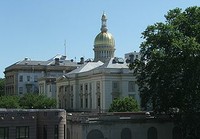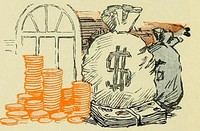High Tax Burden Through the Years: Few New Jerseyans Believe They Get What They Pay for, According to Rutgers-Eagleton Poll

At least one thing endures, however. For four decades, Garden State voters have said they pay too much in state and local taxes for what they get in return. Even as Gov. Chris Christie touts his proposed income tax cut, a new Rutgers-Eagleton Poll finds that only 18 percent of registered voters say they get their money’s worth from the taxes they pay. The vast majority, 76 percent, disagree.
A review of 40 years of Rutgers-Eagleton polls reveals that this belief is nothing new. In 1972, before the passage of the state income tax, 73 percent of respondents said they paid too much for services. Only in 1984 did fewer than 70 percent say they did not get their money’s worth; 64 percent were disgruntled while 29 percent thought they paid the right amount for services.
Voters also recognize New Jersey is a high tax state: 85 percent say they pay more than other states. But that recognition was slow in coming. In 1972, fewer than 10 percent thought they paid more. By 1984 this had climbed above 50 percent, and it has continued a steady rise since.
“Historical data show that state and local taxes in New Jersey have been among the highest in the nation for at least the past 40 years.” said David Redlawsk, poll director and professor of political science at Rutgers University. “But it took a while for people to fully recognize that fact, even though complaints about taxes have been around as long as taxes themselves.”
New results are from a poll of 914 registered voters conducted statewide among both landline and cell phone households from Feb. 9-11. The full sample has a margin of error of +/- 3.3 percentage points. Data from older surveys comes from the publicly available Rutgers-Eagleton Poll archives at eagletonpoll.rugers.edu with margins of error from +/- 2.8 to +/-4.4 percentage points.
New Jersey and Taxes
As previously reported, more than half of voters (52 percent) support Christie’s proposed 10 percent cut in the state income tax while 36 percent are opposed. Even so, 76 percent would rather see property taxes cut first, though most wouldn’t balk at saving tax money from either source. However, most overestimate what a 10 percent state income tax cut would mean, with a median expected savings of nearly $750, compared to a typical cut of about $100 for median-income earners.
Driving both findings may be the widespread belief that more is paid than is gotten in return. Moreover, awareness that New Jersey sits at the top of the list of high-tax states is now pervasive.
“While voters may not really know what an income tax cut means to them, they are painfully aware of the state’s reputation as one of the most highly taxed in the nation,” said Redlawsk. “Whatever the amount they’ll get from a tax cut, they no doubt hope it will ease some of the pain.”
Since the first Rutgers-Eagleton Poll in 1972, data shows that New Jerseyans do not feel they get a good return on their tax dollars – 21 percent thought they “got their money’s worth” from state and local tax payments, and 73 percent felt otherwise. Twelve years later, attitudes improved a bit, with 29 percent saying they got their money’s worth and 64 percent believing

While New Jersey’s tax rates have been among the top five nationally since the 1970s, voters did not realize this in 1972, when only 9 percent said they paid more than other states, while 44 percent thought they paid the same and a third actually believed they paid less.
“The view that we pay less than other states is now as rare as declining property taxes,” said Redlawsk, noting that only 1 percent of New Jerseyans now think they pay less, while 85 percent say they pay more than in other states.
Republicans express the most negativity, but this wasn’t always been the case
In 1972, more Republicans (27 percent) than Democrats (20 percent) thought they got what they paid for with their taxes, but in both 1984 and 1990 there was virtually no difference between the parties. Today, state and local taxes are a major issue for Republicans; 80 percent say they pay too much in state and local taxes and only 13 percent feel they are getting their money’s worth.
Democrats are slightly more positive, with 22 percent saying they get their money’s worth. Nevertheless, most Democrats (71 percent) and independents (78 percent) feel they pay too much.
In 1972, fewer than 10 percent of all voters thought New Jersey’s taxes were higher than those in other states. By 1984, that number increased to about 50 percent of Democrats and Republicans, and nearly 67 percent of independents. Since 2000, Republicans’ perception of New Jersey as highly taxed grew 16 percentage points to 91 percent. Democrats’ perception has remained relatively steady and stands at 79 percent.
Higher earning residents generally have been more likely to say they get their money’s worth from their state and local taxes than those making less. This group also has been more likely to recognize New Jersey’s high tax status. Today, 23 percent of those earning between $100,000 and $150,000 annually say they get their money’s worth. The very highest earners are somewhat less likely to agree (19 percent), and those with incomes between $50,000 and $100,000 are least positive at only 14 percent. High-income voters are also much more likely to recognize New Jersey’s position among states: 93 percent of the wealthiest say New Jersey pays more, compared to only 76 percent of those making less than $50,000.
The best educated voters are more likely to think they get their money’s worth from their taxes, though fewer than 25 percent feel this way. Liberals are among the most positive at 27 percent, while only 13 percent of conservative agree. And 23 percent of retired voters say they get value for money, but this drops to 16 percent of full-time workers and 13 percent of those not employed.
“Even with these differences among groups, the clear story is that New Jerseyans have never really felt they got their money’s worth out of their taxes, at least since we’ve been asking,” said Redlawsk. “And while it took a while, the perception of where New Jersey stands relative to the rest of the states has now caught up with reality.”
Media Contact: David Redlawsk
732-932-9384, ext. 285
E-mail: redlawsk@rutgers.edu